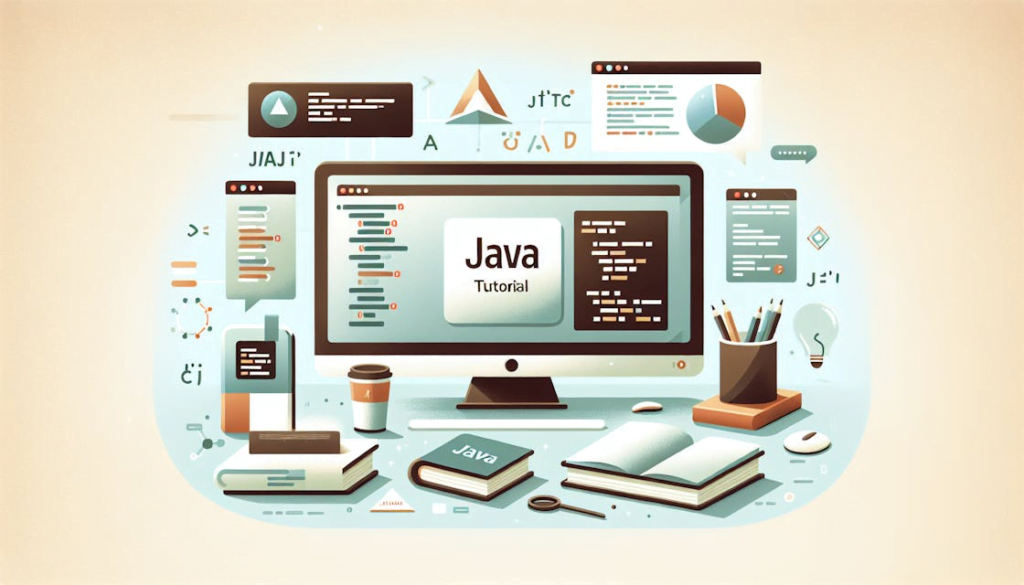
Introduction to Java Programming
Welcome to “Cracking the Code: A Beginner’s Java Tutorial for Junior Developers.” Let’s jump into the basics of Java programming and check out its cool features.
Understanding Java Basics
Java is like the Swiss Army knife of programming languages—versatile and handy. It’s an object-oriented language, meaning everything revolves around objects that chat with each other through method calls. Java was built to be portable, simple, and secure. Its clean and straightforward syntax makes it a breeze to learn. In Java, everything is an object, which makes it super intuitive for many tasks.
Here’s the lowdown on Java’s key components:
- Classes: Think of these as blueprints for creating objects.
- Objects: These are instances of classes that interact with each other.
- Methods: Functions inside a class that describe what objects can do.
- Instance Variables: Variables defined in a class, with each object having its own copy.
Java is case-sensitive, so Variable and variable are two different things (GeeksforGeeks). Identifiers can start with a letter, a currency symbol, or an underscore, but steer clear of Java keywords.
The main() method is the starting point of any Java application and must be defined correctly to run the program (GeeksforGeeks). For more on Java methods, check out our guide on Java Methods.
Key Features of Java
Java has some standout features that make it a favorite among developers. Here are the highlights:
- Platform Independence: Write your code once, and it runs anywhere—Windows, Linux, Mac/OS. This magic happens thanks to the Java Virtual Machine (JVM).
- Object-Oriented: Everything in Java is an object, making it easier to model real-world scenarios. Concepts like inheritance, polymorphism, and encapsulation are baked in. For a deep dive into inheritance, see our article on Java Inheritance.
- Security: Java is known for creating secure, virus-free, tamper-free systems.
- Robustness: With strong memory management, exception handling, and type checking at compile-time and runtime, Java is rock-solid.
- Multithreading: Java supports multithreading, so you can run multiple threads simultaneously.
- High Performance: Java achieves high performance with Just-In-Time compilers.
- Distributed: Java is built for the internet, enabling the development of networked applications.
- Dynamic: Java programs carry a lot of runtime information, which helps in verifying and resolving accesses to objects at runtime.
These features make Java a versatile and powerful programming language. For more on Java’s memory management and garbage collection, check out our section on Java Garbage Collection Process.
With these basics under your belt, you’re ready to dive into Java programming. Keep exploring more topics and sharpen your skills in this versatile language.
Java Syntax and Structure
Getting the hang of Java’s syntax and structure is a must for any newbie developer. Let’s break down the essentials: objects, methods, identifiers, and the main method.
Objects and Methods in Java
Java’s all about objects and how they interact. Think of an object as a real-world thing with properties (states) and actions (behaviors). Classes are like blueprints for these objects, defining what they can do and what they hold.
Key Components:
- Classes: Blueprints for objects.
- Objects: Instances of classes.
- Methods: Actions objects can perform.
- Instance Variables: Properties of objects.
Here’s a simple example to make it clear:
public class Dog {
// Instance variables
String breed;
int age;
// Method
void bark() {
System.out.println("Woof!");
}
public static void main(String[] args) {
// Creating an object
Dog myDog = new Dog();
myDog.breed = "Labrador";
myDog.age = 5;
myDog.bark(); // Calling the method
}
}
In this example:
Dogis a class.myDogis an object of theDogclass.barkis a method.breedandageare instance variables.
For more on methods, check out our article on Java methods.
Identifiers and Main Method
Identifiers are names for things like variables, methods, and classes. They have some rules:
- Start with a letter, $, or _.
- Case-sensitive.
- No reserved keywords.
Here’s a quick table to sum it up:
| Rule | Example |
|---|---|
| Start with a letter, $, or _ | myVariable, $price, _temp |
| Case-sensitive | myVar and myvar are different |
| No reserved keywords | int class = 5; // Incorrect |
The main method is where Java programs start. It looks like this:
public static void main(String[] args) {
// Code to be executed
}
Key Points of the Main Method:
- public: Accessible from anywhere.
- static: No need to create an object to call it.
- void: Doesn’t return anything.
- String[] args: Array of command-line arguments.
Example:
public class HelloWorld {
public static void main(String[] args) {
System.out.println("Hello, World!");
}
}
For more on arrays, check out our article on Java arrays.
Grasping objects, methods, identifiers, and the main method is key to mastering Java. For more advanced stuff like inheritance and loops, dive into our articles on Java inheritance and Java loops.
Java Data Types: A Fun Dive
Alright, folks, let’s talk about Java data types. If you’re knee-deep in a Java tutorial, you know that getting a grip on data types is like learning the ABCs of coding. Java splits its data types into two big buckets: Primitive Data Types and Reference/Object Data Types. Let’s break these down without the snooze-fest.
Primitive Data Types
Primitive data types are the building blocks of Java. Think of them as the basic ingredients in your coding kitchen. They come in eight flavors, each with its own size and default value. Here’s the lowdown:
| Data Type | Size in Bits | Default Value | What It Does |
|---|---|---|---|
boolean | 1 | false | True or false, no in-between. |
byte | 8 | 0 | Tiny 8-bit signed number. |
short | 16 | 0 | 16-bit signed number, slightly bigger. |
int | 32 | 0 | Standard 32-bit signed number. |
long | 64 | 0L | Big 64-bit signed number. |
float | 32 | 0.0f | 32-bit floating point, for decimals. |
double | 64 | 0.0d | 64-bit floating point, for more precise decimals. |
char | 16 | '' | Single 16-bit Unicode character. |
Java is a stickler for rules. You gotta declare a variable’s type before using it. This helps catch mistakes early, saving you from a world of debugging pain (W3Schools).
Reference/Object Data Types
Now, let’s get fancy with Reference or Object data types. These are more complex and store addresses of values rather than the values themselves (GeeksforGeeks). Here are some you’ll bump into:
- Strings – Store sequences of characters. Think words and sentences.
- Arrays – Collections of similar data types. Like a box of chocolates, but you know what’s inside.
- Objects – Instances of classes that can hold multiple types of data. Your custom-built Swiss Army knife.
- Interfaces – Abstract types that define methods a class must implement. Think of them as contracts.
Unlike primitives, reference types come with bells and whistles. For instance, the String class has methods like length(), charAt(), and substring() to make string manipulation a breeze.
Getting a handle on these data types is key to writing slick, error-free Java code. Dive deeper into Java methods and Java arrays to level up your coding game. Happy coding!
Memory Management in Java
Getting a grip on memory management is a must for any budding Java developer. Let’s break down how Java handles memory with its garbage collection process and the structure of the Java Virtual Machine (JVM) memory.
Java Garbage Collection Process
Java’s garbage collection is like a tidy robot that cleans up memory by getting rid of unused code. This automated process frees up memory space, making life easier for developers (New Relic).
The garbage collection process in Java uses a mark-and-sweep algorithm. This algorithm scans the heap, finds objects that are no longer in use, and removes them to free up memory. There are several types of garbage collectors in Java, each with its own perks and quirks:
- Serial Collector: Best for single-threaded environments.
- Parallel Collector: Great for multi-threaded applications.
- Concurrent Mark-and-Sweep (CMS) Collector: Cuts down pause times by working alongside the application.
- Garbage First (G1) Collector: Collects both young and old generations concurrently, splitting the heap into many small regions.
Here’s a quick comparison of these garbage collectors:
| Garbage Collector | Best For | Main Advantage | Main Disadvantage |
|---|---|---|---|
| Serial Collector | Single-threaded apps | Simple and efficient | Not for large applications |
| Parallel Collector | Multi-threaded apps | High throughput | Longer pause times |
| CMS Collector | Low-latency apps | Low pause times | Higher CPU usage |
| G1 Collector | Large heaps | Predictable pause times | Complex tuning |
JVM Memory Structure
The Java Virtual Machine (JVM) memory structure is split into several areas, each with its own job. Knowing these areas helps you manage memory better.
- Method Area: Stores class structures, including class names, super class names, interfaces, and constructors (JavaTpoint).
- Heap Area: Stores objects created during program execution. This is where the garbage collector does its thing.
- Stack Area: Contains stack frames, which hold local variables and partial results. Each thread has its own stack.
- Program Counter (PC) Register: Holds the address of the JVM instruction currently being executed.
- Native Method Stack: Contains all the native methods used in the application.
Here’s a table summarizing the JVM memory areas:
| Memory Area | Description | Purpose |
|---|---|---|
| Method Area | Stores class structures | Holds class metadata |
| Heap Area | Stores objects | Managed by garbage collector |
| Stack Area | Contains stack frames | Holds local variables and partial results |
| PC Register | Holds the address of the current instruction | Tracks execution |
| Native Method Stack | Contains native methods | Executes native code |
For more Java goodness, check out our articles on java loops, java arrays, and java inheritance. Mastering these topics will level up your Java skills.









